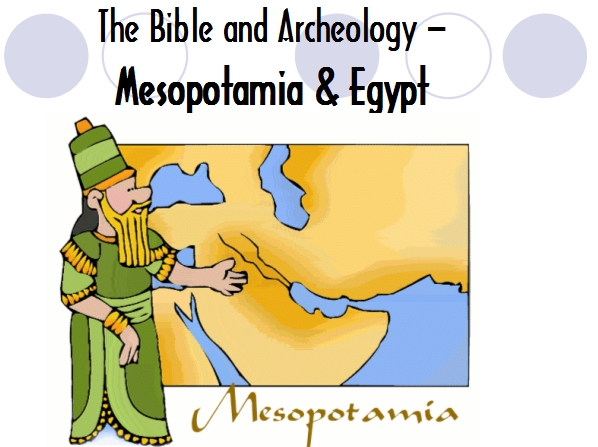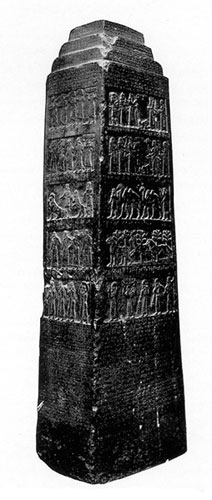|
DPS Biblical
Archeology Study Outline
4. Mesopotamia & Egypt
|

Download: Teacher's Script (PDF)
(Word) | Handout
(PDF( (Word)
| PowerPoint
Overview
a. Inscriptions and Writings:
Black Obelisk of Shalmaneser III
b. Mesopotamia & Egypt - a
geology shapes theology
i. Outline of Early Mesopotamian History
1.
Proto-Literary Period.
2.
The Early Dynastic Period.
3.
Sargon the Great (Died 2330 B.C.)
4. The Third Dynasty of Ur
The Ziggurat
The Fall uf Ur
ii. Contrast between Ancient Egypt and Mesopotamia
Discussion Questions
a. Inscriptions and Writings:
Black Obelisk of Shalmaneser III
 It
is the most complete Assyrian obelisk yet discovered, and is
historically significant because it displays the earliest ancient
depiction of an Israelite. It was erected as a public monument in 825
BCE at a time of civil war. It
is the most complete Assyrian obelisk yet discovered, and is
historically significant because it displays the earliest ancient
depiction of an Israelite. It was erected as a public monument in 825
BCE at a time of civil war.
The second register from the top includes the earliest surviving picture
of an Israelite: the Biblical Jehu, king of Israel. It describes how
Jehu brought or sent his tribute in or around 841 BCE.
Jehu severed Israel’s alliances with Phoenicia and Judah, and became
subject to Assyria. The caption above the scene, written in Assyrian
cuneiform, can be translated:
“The tribute of Jehu, son of Omri: I received from him silver, gold, a
golden bowl, a golden vase with pointed bottom, golden tumblers, golden
buckets, tin, a staff for a king [and] spears."
b. Mesopotamia & Egypt - a geology shapes theology
i.
Outline of Early Mesopotamian History
1.
Proto-Literary Period.
Our earliest samples of writing begin around 3500 B.C. This writing is
found in the form of round cylinders which were impressed with a message
and then baked. There are two main uses:
a.
Religious and cultic uses.
b. Cooking recipes.
This tells us something about the people of the ancient world. They are
essentially like modern people. Even though the product of differing
cultures and times, they have the same basic needs and desires.
The earliest writing was in the form of pictographs where a single
picture would represent a single object. These developed into ideographs
and from there to a system of wedge-shaped characters made on soft
tablets of clay with a triangular stick or cunios. This writing became
known as cuneiform.
2.
The Early Dynastic Period.
From 3000 B.C. to about 2300 B.C. various city-states gained supremacy
over their neighbors, establishing short periods of suzerainty.
-
Kish – located in central Mesopotamia near Babylon.
-
Erech – Neighbor to Ur.
-
Ur – City from which Abraham came.
-
Lagesh – 35 miles northeast of Erech.
It
was during this period that Gilgamesh became king of Erech (2650 B.C.).
Myths and legends grew of his exploits. The “Gilgamesh Epic” recounts
his quest for immortality and his conflicts with monsters and enemies
along the way.
This was the “golden age” of Sumerian civilization. Its works of art
were unparalleled in later ages.
“So far as we know, the fourth millennium before Christ saw Sumerian art
at its zenith. By the First Dynasty of Ur, if there is any change, it is
in the nature of a decadence, and from later ages we have nothing to
parallel the treasures of the prehistoric tombs.”
(C. Leonard Wooley, The Sumerians, 1965, pg 44).
As
there were advances in the arts, so there were also advances in the
modes of war. Infantry tactics developed which involved phalanxes of
soldiers carrying short spears and supported by lightly armed
skirmishers.
3.
Sargon the Great (Died 2330 B.C.).
A
text written in the 7th century B.C. describes Sargon’s birth and early
life in terms very similar to that of Moses. According to this legend,
his mother placed him in a pitch-covered basket in the Euphrates River.
By chance a farmer drawing water to irrigate his field found the basket
and raised the child as his own. Sargon went on to become the cup bearer
to the king of Kish and eventually overthrew the king and placed himself
on the throne, taking for himself the name “Sargon.”
4. The Third Dynasty of Ur.
This was to be the last Sumerian dynasty to rule in Mesopotamia. It
would rule from 2100 to 2000 B.C. Under these kings, Sumer was restored
to much of her former glory. All branches of the arts saw a period of
renaissance as economic prosperity became the order of the day.
The Ziggurat.
The Ziggurat of Ur was a giant, semi-pyramidal structure of brick
covering an area of 200 by 140 feet. It was composed of three terraced
stages and crowned by a small shrine towering 90 feet above the city.
Although it looked something like the pyramids of Egypt, the purpose of
the ziggurat was widely different. It was believed to be a sunbathed
ladder to the gods, connecting heaven and earth.
One
cannot help but wonder if a ziggurat was what was referenced in the
biblical account of the
Tower of Babel. Ziggurats were not unique to Ur. They were found
throughout Mesopotamia.
Now the whole earth used the same language and the same words.
And it came about as they journeyed east, that they found a plain in
the land of Shinar and settled there.
And they said to one another, “Come, let us make bricks and burn them
thoroughly.” And they used brick for stone, and they used tar for
mortar. And they said, “Come, let us build for ourselves a city, and a
tower whose top will reach into heaven, and let us make for ourselves
a name; lest we be scattered abroad over the face of the whole earth.”
(Genesis 11:1-4).
The phrase whose top will reach into heaven can be translated,
“its top unto the heavens” and have the sense, not of a means to get
into the sky, but a temple which would allow the worshiper to approach
God on his own terms.
c The Fall of Ur.
Near the close of the 21st century, a people known as the Amurru
(Biblical Amorites) began to move into Mesopotamia from the northwest,
conquering the cities of Babylon, Isin and Larsa. The armies of Sumer
managed to hold them off for a time, but then the Elamite provinces in
the east declared their independence. Many of the provincial governors
took this opportunity to revolt. Thus weakened, Ur fell to the assault
of Elam and her king carried off into captivity.
With the destruction of Ur, the dominance of the Sumerian people came
to a close. But their culture lived on as it was adopted by the
Assyrians in the north and the Amorites in the south. These and
succeeding kingdoms adopted the Sumerian pantheon as well as their
cuneiform methods of writing, adapting it to their own languages.
ii. Contrast between Ancient Egyptian and Mesopotamian
Theology
Mesopotamia
|
Egypt
|
Legalistic in their religious outlook, looking more to the
letter of the law.
|
More of an ethical outlook on life with a focus on the spirit of
the law.
|
Art and literature reflects a gloomy, pessimistic outlook on
life.
|
Demonstrates a cheerful resignation to the problems of life.
|
Euphrates and Tigris flooded unexpectedly and often killed those
who were caught. These rivers came to be feared.
|
The Nile flooded on a regular cycle and the Egyptians came to
expect and depend upon its flooding. They eventually began to
worship the Nile.
|
Surrounded by hostile forces on all sides. People lived in
constant fear of invasion.
|
Egypt has natural boundaries in the sea and the desert which
usually kept out invaders.
|
Lived from day to day always in fear of invasion and death.
|
Looked forward to immortality and a life after death.
|
Selfish and practical.
|
Giving and idealistic.
|
Discussion Questions:
How
does it make you feel to know that so many details of the biblical
stories can be found in the history, archeology, and geography of
ancient Mesopotamia and Egypt? Does it surprise you that
apparently the geography and natural events have an influence on how
theology was shaped in the ancient world?
t
|